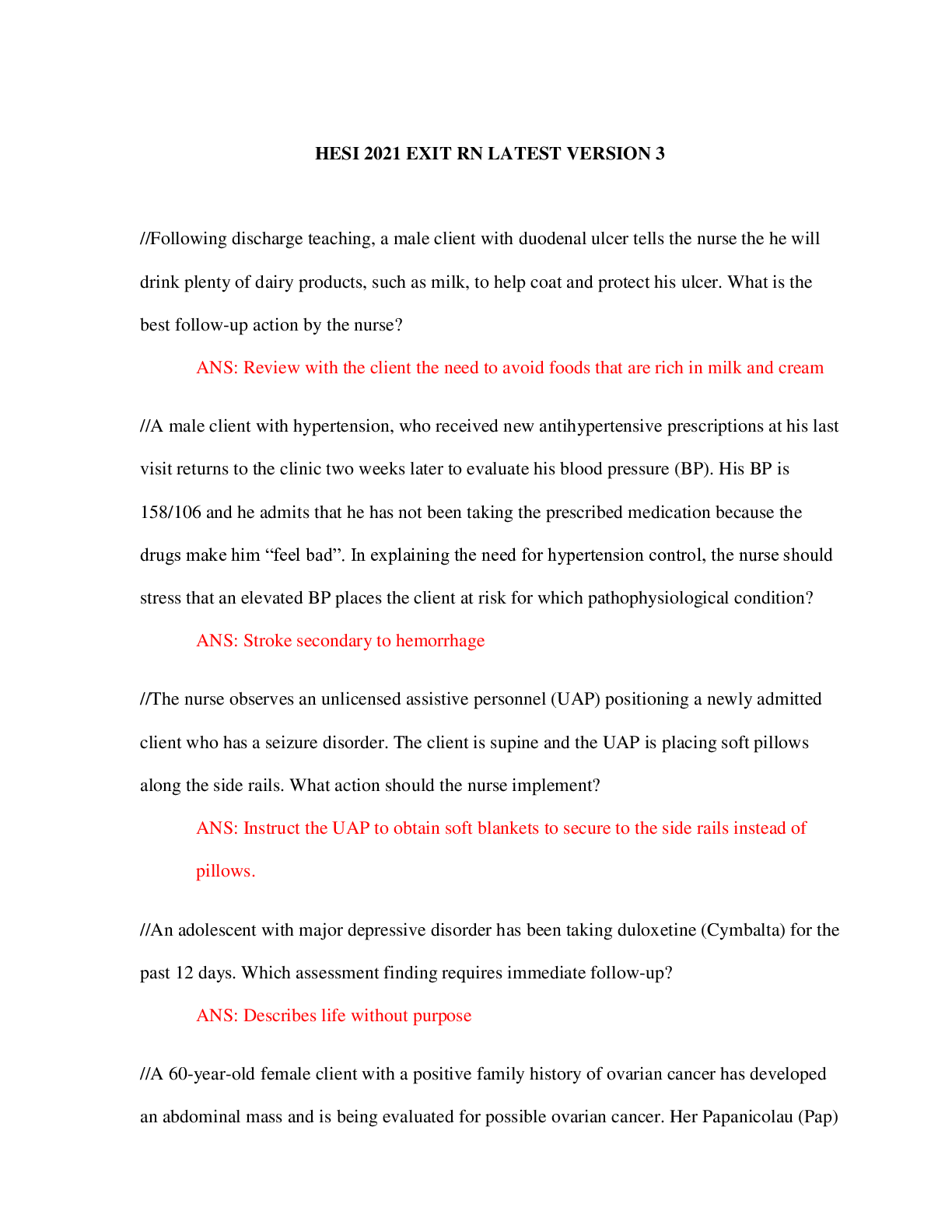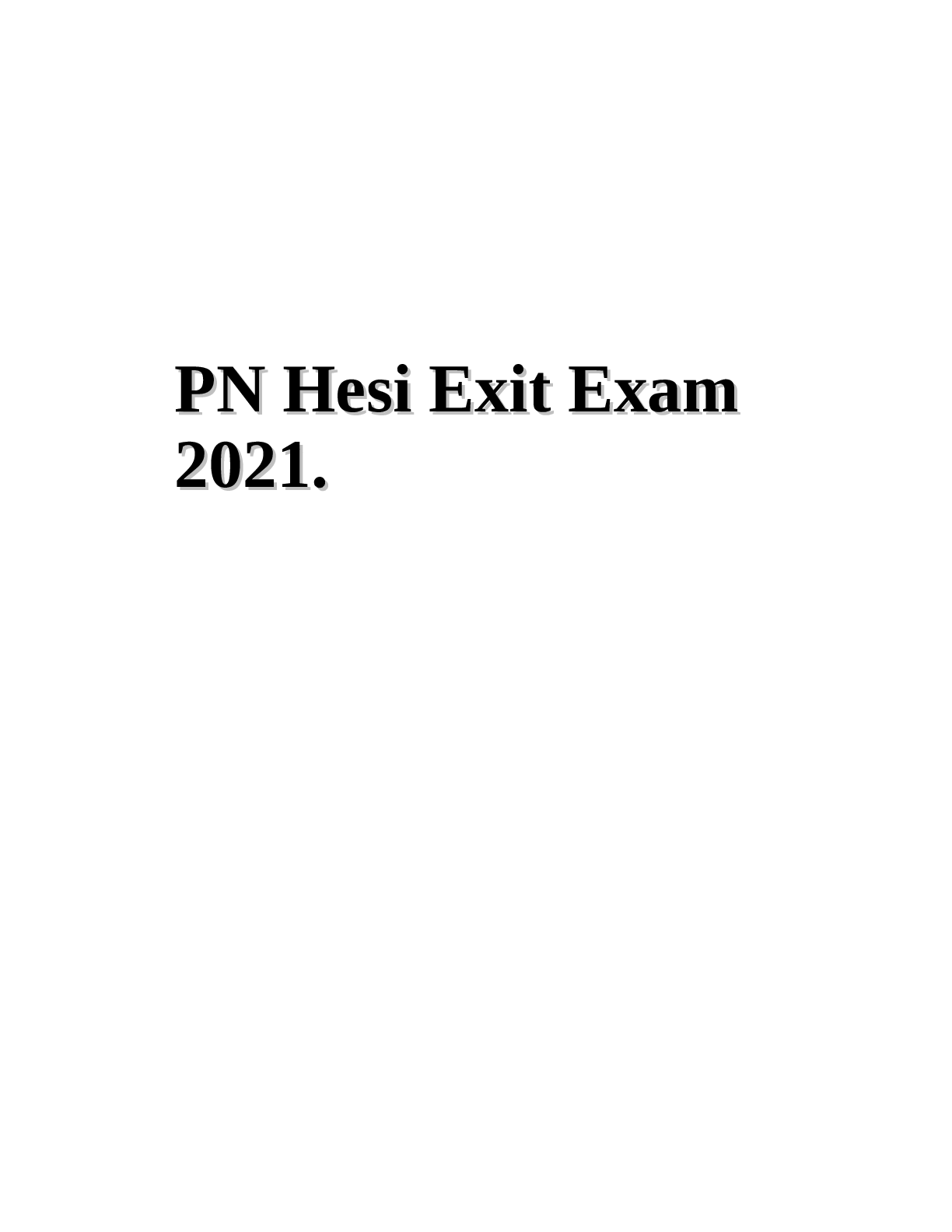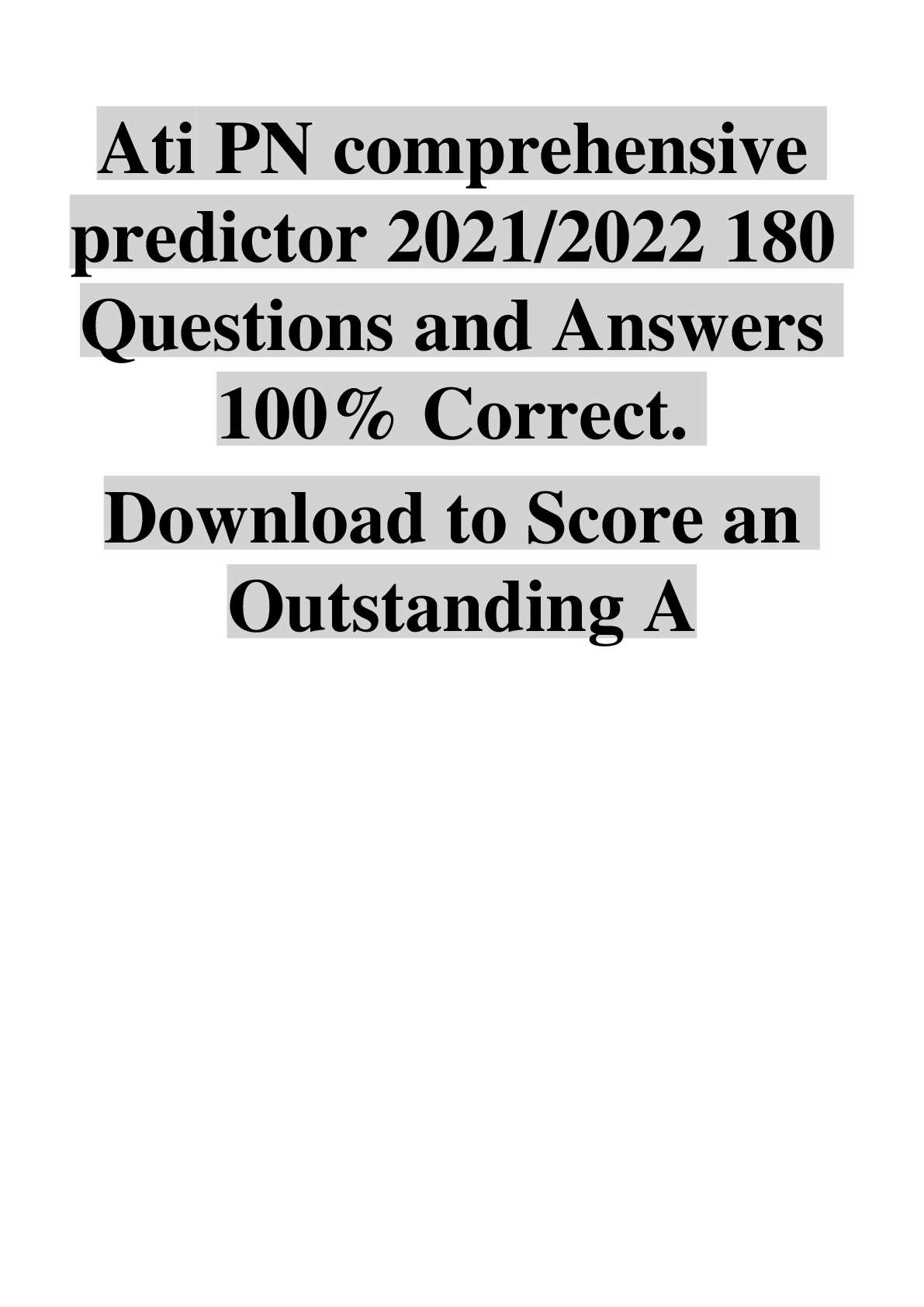*NURSING > HESI > {SOLVED} HESI HEALTH ASSESSMENT NURSING RN V1 100 Questions with answers | Download To Score A (All)
{SOLVED} HESI HEALTH ASSESSMENT NURSING RN V1 100 Questions with answers | Download To Score A
Document Content and Description Below
HESI HEALTH ASSESSMENT NURSING RN V1 100 Questions with answers 1. During a mental status examination, the nurse wants to assess a patient’s affect. The nurse should ask the patient which quest... ion? “How do you feel today?” 2. The nurse is planning to assess new memory with a patient. The best way for the nurse to do this would be to: Give him the Four Unrelated Words Test. 3. A 45-year-old woman is at the clinic for a mental status assessment. In giving her the Four Unrelated Words Test, the nurse would be concerned if she could not four unrelated words . Recall; after a 30-minute delay 4. During a mental status assessment, which question by the nurse would best assess a person’s judgment? “Tell me what you plan to do once you are discharged from the hospital.” 5. Which of these individuals would the nurse consider at highest risk for a suicide attempt? Older adult man who tells the nurse that he is going to “join his wife in heaven” tomorrow and plans to use a gun 6. When reviewing the use of alcohol by older adults, the nurse notes that older adults have several characteristics that can increase the risk of alcohol use. Which would increase the bioavailability of alcohol in the blood for longer periods in the older adult? Decreased liver and kidney functioning 7. During an assessment, the nurse asks a female patient, “How many alcoholic drinks do you have a week?” Which answer by the patient would indicate at-risk drinking? “I have seven or eight drinks a week, but I never get drunk.” 8. The nurse is asking an adolescent about illicit substance abuse. The adolescent answers, “Yes, I’ve used marijuana at parties with my friends.” What is the next question the nurse should ask? “When was the last time you used marijuana?” 9. The nurse has completed an assessment on a patient who came to the clinic for a leg injury. As a result of the assessment, the nurse has determined that the patient has at-risk alcohol use. Which action by the nurse is most appropriate at this time? State, “You are drinking more than is medically safe. I strongly recommend that you quit drinking, and I’m willing to help you.” 10. A patient is brought to the emergency department. He is restless, has dilated pupils, is sweating, has a runny nose and tearing eyes, and complains of muscle and joint pains. His girlfriend thinks he has influenza, but she became concerned when his temperature went up to 39.4° C. She admits that he has been a heavy drug user, but he has been trying to stop on his own. The nurse suspects that the patient is experiencing withdrawal symptoms from which substance? Heroin 11. Patient taking ipratropium reports nausea, blurred vision, has, insomnia after using the inhaler. RN action to implement - withhold med and report symptoms 12. A patient has suddenly developed shortness of breath and appears to be in significant respiratory distress. After calling the physician and placing the patient on oxygen, which of these actions is the best for the nurse to take when further assessing the patient? Bilaterally percuss the thorax, noting any differences in percussion tones. 13. The nurse is teaching a class on basic assessment skills. Which of these statements is true regarding the stethoscope and its use? Although the stethoscope does not magnify sound, it does block out extraneous room noise. 14. The nurse is preparing to use a stethoscope for auscultation. Which statement is true regarding the diaphragm of the stethoscope? The diaphragm: Is used to listen for high-pitched sounds. 15. Before auscultating the abdomen for the presence of bowel sounds on a patient, the nurse should: Check the temperature of the room, and offer blankets to the patient if he or she feels cold. 16. While measuring a patient’s blood pressure, the nurse recalls that certain factors, such as , help determine blood pressure. Peripheral vascular resistance 17. A nurse is helping at a health fair at a local mall. When taking blood pressures on a variety of people, the nurse keeps in mind that: The blood pressure of a Black adult is usually higher than that of a White adult of the same age. 8. The nurse notices a colleague is preparing to check the blood pressure of a patient who is obese by using a standard-sized blood pressure cuff. The nurse should expect the reading to: Yield a falsely high blood pressure. 19. A student is late for his appointment and has rushed across campus to the health clinic. The nurse should: Allow 5 minutes for him to relax and rest before checking his vital signs. 20. Hypoptysis (new cough) or changes in persistent cough tuberculosis s/sx 21. The nurse is assessing a patient’s pain. The nurse knows that the most reliable indicator of pain would be the: Subjective report. 22. A patient has had arthritic pain in her hips for several years since a hip fracture. She is able to move around in her room and has not offered any complaints so far this morning. However, when asked, she states that her pain is “bad this morning” and rates it at an 8 on a 1-to-10 scale. What does the nurse suspect? The patient: Has experienced chronic pain for years and has adapted to it. 23. The nurse is reviewing the principles of pain. Which type of pain is due to an abnormal processing of the pain impulse through the peripheral or central nervous system? Neuropathic 24. The nurse hears bilateral loud, long, and low tones when percussing over the lungs of a 4-year-old child. The nurse should: Consider this finding as normal for a child this age, and proceed with the examination. 25. When assessing the quality of a patient’s pain, the nurse should ask which question? “What does your pain feel like?” 26. When assessing a patient’s pain, the nurse knows that an example of visceral pain would be: Cholecystitis. 27. A 75-year-old woman who has a history of diabetes and peripheral vascular disease has been trying to remove a corn on the bottom of her foot with a pair of scissors. The nurse will encourage her to stop trying to remove the corn with scissors because: The woman could be at increased risk for infection and lesions because of her chronic disease. 28. The nurse keeps in mind that a thorough skin assessment is extremely important because the skin holds information about a person’s: Circulatory status. 29. A patient comes in for a physical examination and complains of “freezing to death” while waiting for her examination. The nurse notes that her skin is pale and cool and attributes this finding to: Peripheral vasoconstriction. 30. A patient comes to the clinic and tells the nurse that he has been confined to his recliner chair for approximately 3 days with his feet down and he asks the nurse to evaluate his feet. During the assessment, the nurse might expect to find: Caused by the complete absence of melanin pigment 31. The nurse will perform a palpated pressure before auscultating blood pressure. The reason for this is to: Detect the presence of an auscultatory gap. 32. A patient tells the nurse that he has noticed that one of his moles has started to burn and bleed. When assessing his skin, the nurse pays special attention to the danger signs for pigmented lesions and is concerned with which additional finding? Color variation 33. sarcoidosis - autoimmune inflammatory disease affecting multiple organs - improved pulse oximetry values 34. A 19-year-old college student is brought to the emergency department with a severe headache he describes as, “Like nothing I’ve ever had before.” His temperature is 40° C, and he has a stiff neck. The nurse looks for other signs and symptoms of which problem? Meningeal inflammation 35. During a well-baby checkup, the nurse notices that a 1-week-old infant’s face looks small compared with his cranium, which seems enlarged. On further examination, the nurse also notices dilated scalp veins and downcast or “setting sun” eyes. The nurse suspects which condition? Hydrocephalus 36. The nurse needs to palpate the temporomandibular joint for crepitation. This joint is located just below the temporal artery and anterior to the: Tragus. 37. A patient has come in for an examination and states, “I have this spot in front of my ear lobe on my cheek that seems to be getting bigger and is tender. What do you think it is?” The nurse notes swelling below the angle of the jaw and suspects that it could be an inflammation of his: Parotid gland. 38. A male patient with a history of acquired immunodeficiency syndrome (AIDS) has come in for an examination and he states, “I think that I have the mumps.” The nurse would begin by examining the: Parotid gland. 39. In performing an examination of a 3-year-old child with a suspected ear infection, the nurse would: Perform the otoscopic examination at the end of the assessment. 40. The nurse is preparing to perform an otoscopic examination of a newborn infant. Which statement is true regarding this examination? The normal membrane may appear thick and opaque. 41. The nurse assesses the hearing of a 7-month-old by clapping hands. What is the expected response? The infant: Turns his or her head to localize the sound. 42. The nurse is performing an ear examination of an 80-year-old patient. Which of these findings would be considered normal? High-tone frequency loss 43. An assessment of a 23-year-old patient reveals the following: an auricle that is tender and reddish- blue in color with small vesicles. The nurse would need to know additional information that includes which of these? Any prolonged exposure to extreme cold 44. A pregnant woman states that she is concerned about her gums because she has noticed they are swollen and have started bleeding. What would be an appropriate response by the nurse? “Swollen and bleeding gums can be caused by the change in hormonal balance in your system during pregnancy.” 45. A 40-year-old patient who has just finished chemotherapy for breast cancer tells the nurse that she is concerned about her mouth. During the assessment the nurse finds areas of buccal mucosa that are raw and red with some bleeding, as well as other areas that have a white, cheesy coating. The nurse recognizes that this abnormality is: Candidiasis. 46. The nurse is assessing a patient in the hospital who has received numerous antibiotics and notices that his tongue appears to be black and hairy. In response to his concern, what would the nurse say? “Black, hairy tongue is a fungal infection caused by all the antibiotics you have received.” 47. The nurse is assessing a patient with a history of intravenous drug abuse. In assessing his mouth, the nurse notices a dark red confluent macule on the hard palate. This could be an early sign of: Acquired immunodeficiency syndrome (AIDS). 48. A mother brings her 4-month-old infant to the clinic with concerns regarding a small pad in the middle of the upper lip that has been there since 1 month of age. The infant has no health problems. On physical examination, the nurse notices a 0.5-cm, fleshy, elevated area in the middle of the upper lip. No evidence of inflammation or drainage is observed. What would the nurse tell this mother? “This elevated area is a sucking tubercle caused from the friction of breastfeeding or bottle- feeding and is normal.” 49. which finding should RN assess for a pt for a risk of DI (diabetes insipidus) – polydipsia 50. During percussion, the nurse knows that a dull percussion note elicited over a lung lobe most likely results from: . Increased density of lung tissue. 51. The nurse is observing the auscultation technique of another nurse. The correct method to use when progressing from one auscultatory site on the thorax to another is comparison. Side-to-side 52. When auscultating the lungs of an adult patient, the nurse notes that low-pitched, soft breath sounds are heard over the posterior lower lobes, with inspiration being longer than expiration. The nurse interprets that these sounds are: Vesicular breath sounds and normal in that location. 53. The nurse is auscultating the chest in an adult. Which technique is correct? Firmly holding the diaphragm of the stethoscope against the chest 54. The nurse is percussing over the lungs of a patient with pneumonia. The nurse knows that percussion over an area of atelectasis in the lungs will reveal: Dullness. 55. During the precordial assessment on an patient who is 8 months pregnant, the nurse palpates the apical impulse at the fourth left intercostal space lateral to the midclavicular line. This finding would indicate: Displacement of the heart from elevation of the diaphragm. 56. In assessing for an S4 heart sound with a stethoscope, the nurse would listen with the: Bell of the stethoscope at the apex with the patient in the lef t lateral position. 57. A 70-year-old patient with a history of hypertension has a blood pressure of 180/100 mm Hg and a heart rate of 90 beats per minute. The nurse hears an extra heart sound at the apex immediately before the S1. The sound is heard only with the bell of the stethoscope while the patient is in the left lateral position. With these findings and the patient’s history, the nurse knows that this extra heart sound is most likely a(n): Atrial gallop. 58. The nurse is performing a cardiac assessment on a 65-year-old patient 3 days after her myocardial infarction (MI). Heart sounds are normal when she is supine, but when she is sitting and leaning forward, the nurse hears a high-pitched, scratchy sound with the diaphragm of the stethoscope at the apex. It disappears on inspiration. The nurse suspects: Inflammation of the precordium. 59. When the nurse is testing the triceps reflex, what is the expected response Extension of the forearm 60. The nurse is testing superficial reflexes on an adult patient. When stroking up the lateral side of the sole and across the ball of the foot, the nurse notices the plantar flexion of the toes. How should the nurse document this finding? Plantar reflex present 61. OTC decongestants - - can increase ICP - can Increase HR and BP 62. In the assessment of a 1-month-old infant, the nurse notices a lack of response to noise or stimulation. The mother reports that in the last week he has been sleeping all of the time, and when he is awake all he does is cry. The nurse hears that the infant’s cries are very high pitched and shrill. What should be the nurse’s appropriate response to these findings? Refer the infant for further testing. 63. Which of these tests would the nurse use to check the motor coordination of an 11-month-old infant? Denver II 64. To assess the head control of a 4-month-old infant, the nurse lifts up the infant in a prone position while supporting his chest. The nurse looks for what normal response? The infant: Raises the head, and arches the back. 65. The nurse knows that a common assessment finding in a boy younger than 2 years old is: Presence of a hydrocele, or fluid in the scrotum. 66. During an examination of an aging man, the nurse recognizes that normal changes to expect would be: . Decrease in the size of the penis. 67. When performing a genital assessment on a middle-aged man, the nurse notices multiple soft, moist, painless papules in the shape of cauliflower-like patches scattered across the shaft of the penis. These lesions are characteristic of: Genital warts. 68. A 15-year-old boy is seen in the clinic for complaints of “dull pain and pulling” in the scrotal area. On examination, the nurse palpates a soft, irregular mass posterior to and above the testis on the left. This mass collapses when the patient is supine and refills when he is upright. This description is consistent with: Varicocele. 69. When performing a genitourinary assessment on a 16-year-old male adolescent, the nurse notices a swelling in the scrotum that increases with increased intra-abdominal pressure and decreases when he is lying down. The patient complains of pain when straining. The nurse knows that this description is most consistent with a(n) hernia. Indirect inguinal 70. A woman who is 8 weeks pregnant is in the clinic for a checkup. The nurse reads on her chart that her cervix is softened and looks cyanotic. The nurse knows that the woman is exhibiting sign and sign. Goodell; Chadwick 71. Generally, the changes normally associated with menopause occur because the cells in the reproductive tract are: Estrogen dependent. 72. The nurse is reviewing the changes that occur with menopause. Which changes are associated with menopause? . Uterine and ovarian atrophy, along with a thinning of the vaginal epithelium 73.primary reason for teaching pt pursed lip breathing - promote CO2 elimination 74. A 54-year-old woman who has just completed menopause is in the clinic today for a yearly physical examination. Which of these statements should the nurse include in patient education? “A postmenopausal woman: Should be aware that she is at increased risk for dyspareunia because of decreased vaginal secretions.” 75. A woman is in the clinic for an annual gynecologic examination. The nurse should plan to begin the interview with the: Menstrual history, because it is generally nonthreatening. 76. During an assessment of a hospitalized patient, the nurse pinches a fold of skin under the clavicle or on the forearm to test the: Mobility and turgor. 77. When assessing the neurologic system of a hospitalized patient during morning rounds, the nurse should include which of these during the assessment? Patient’s ability to communicate 78. When assessing a patient’s general appearance, the nurse should include which question? Does the patient appropriately respond to questions? 79. The nurse is palpating the fundus of a pregnant woman. Which statement about palpation of the fundus is true? After 20 weeks’ gestation, the number of centimeters should approximate the number of weeks’ gestation. 80. The nurse is palpating the abdomen of a woman who is 35 weeks’ pregnant and notices that the fetal head is facing downward toward the pelvis. The nurse would document this as fetal: Presentation. 81. The nurse is palpating the uterus of a woman who is 8 weeks’ pregnant. Which finding would be considered to be most consistent with this stage of pregnancy? It is about the size of an avocado, approximately 8 cm across the fundus. 82. A patient who had recent abdominal surgery is becoming increasingly agitated and confused. He has pulled out his IV and his nasogastric tube. His skin is pale and clammy, heart rate 120 bpm, BP 130/60. The physician has been called. What nursing action is most important at this time? Stay with the patient and have another nurse obtain needed supplies. 83. Which patient is at greatest risk for injury and requires the nurse’s immediate attention? The patient who had a(n): needle liver biopsy 1 hour ago and is now thrashing about in bed and complaining of severe abdominal pain. 84. What could a nurse say who believed that a nursing student has a duty to understand pertinent clinical information to make sound clinical judgments? “You should be honest when critically reflecting on your strengths and weaknesses.” 85. As a graduate nurse, which statement strongly suggests future success in the current nursing practice environment? “I am actively involved in decision-making on the unit.” 86. Which of the following is an example of an anxiety-causing situation below that is potentially caused by a role transition from LPN/LVN to RN? .Managing care based on your knowledge and skills 87. The patient reports intense pain and rates it 10/10. He is talking and laughing on the telephone but interrupts his conversion to request pain medication. The nurse would make a decision about the administration of medication based on which indicator of pain? The patient’s subjective statements about the pain 88. The nurse asks a hospitalized patient to sign the operative consent. The patient tells the nurse, “I do not really understand what is involved in the surgery.” The nurse should: .delay the patient’s signature on the consent form and notify the surgeon that the informed consent process is not complete. 89. If a patient refuses a medication or is undergoing a diagnostic test that results in a missed dose of medication, the nurse will document the omission on the medication administration record and: .document why the dose was not given. 90. A patient weighed 200 lb 6 months ago. He now weighs 160 lb. He has not been trying to lose weight. Based on the defining characteristics of nutrition, less than body requirements, the nurse’s best response would be: “That is a significant weight loss. How would you account for it?” 91. The nurse enters the room of a sleeping patient to administer the 0200 dose of antibiotic that has been ordered every 6 hours. Which action would most effectively maintain a therapeutic blood level of this medication? .Awaken the patient and administer the medication. 92. The nurse is to take a meal tray to a patient the nurse knows nothing about. Before leaving the tray with the patient, which is the most critical safety factor the nurse should determine? The patient’s ability to swallow is intact. 93. A nurse notices that the respiratory therapist assigned to his unit frequently forgets to raise the bed rails after completing treatments. The nurse’s best action is to: discuss the problem with the therapist. 94. A nurse is assigned to care for an elderly, confused patient. The patient’s son is sitting at the bedside and is watching a loud television program. The nurse needs to complete the respiratory and cardiac assessment and vital signs. What would be the best approach to this situation? Say: “I need a quiet environment while I listen to your mother’s chest. I will need to turn the TV down until I’m finished.” 95. A graduate RN on the telemetry unit is on the way to the nurse’s station to chart and suddenly hears from a patient’s room, “Help! Nurse!” This is not the nurse’s assigned patient. Others also hear this cry for help and quickly run in with the crash cart while the graduate RN looks on. In planning care for this patient, the beginning RN must realize the importance of identifying and (select all that apply): correcting weaknesses. leveraging strengths. 96. Which comments by the graduate RN are examples of interventions that will lead to a successful transition into professional nursing? (Select all that apply.) “May I care for patients with COPD? I feel I need more experience with that pulmonary condition.” “Thanks for your insights about knowing when to appropriately call the physician.” “Now that my new role is as an RN, I would like to be treated as any new graduate RN although I’ve worked here as a LVN for 3 years.” 97. When providing discharge teaching for a client with uric acid calculi, the nurse would include an instruction to avoid which type of diet? . high purine 98. Parents of a child diagnosed with bacterial meningitis are asking the nurse questions regarding the disease process. Which description about the development of sequelae in infants with bacterial meningitis is most accurate? They usually occur during the first 2 months of life. 99. The nurse is caring for a client with chronic hypertension who struggles with medication compliance because of financial issues. When reviewing recent lab work results, which reflects the client’s blood pressure issues? Select all that apply. blood urea nitrogen (BUN) . creatinine . calcium 100. The nurse is caring for a client who has a type I second-degree atrioventricular (AV) block. Which ECG rhythm would the nurse expect to see? 4. 101. The nurse is caring for a client who has been placed on phenobarbital 30 mg daily for newly diagnosed seizure activity. Which instruction would be included in client teaching specifically related to anticonvulsant drug efficacy? Maintain a seizure frequency chart. 102. The nurse is caring for a client on hemodialysis who has an arteriovenous (AV) fistula in the right arm. When managing a client’s plan of care, which nursing instructions/actions are appropriate? Select all that apply. . avoiding all blood pressure readings and trauma to the right arm □ 4. assessing the shunt by auscultating a bruit □ 5. completing arm and finger exercises 103. A float nurse is assigned to a surgical unit. The nurse is receiving two clients from the postanesthesia care unit (PACU) at the same time. When delegating tasks to other unit personnel who are not known to the nurse, which question would be most important to ask? . Are you comfortable in performing the tasks being assigned? 103. The nurse is triaging phone calls at a local pediatrician’s office. Which statement by the parent of a child being treated for pinworms indicates that further teaching is needed? “I’ll warn my child to avoid sharing hairbrushes and hats to prevent spreading pinworms to others.” 104. The nurse is caring for a homeless client with pneumonia. Laboratory testing reveals the following results: blood urea nitrogen (BUN) 180 mg/dl (64 mmol/L), creatinine 30 mg/dl (2,652 mmol/L), potassium 6.2 mEq/L (6.2 mmol/L), and hemoglobin 6.2% (62 g/L). Based on the health care provider’s order below, which drug order would the nurse question? . gentamicin sulfate 105. The nurse is caring for a client with a nasogastric tube and in mitt restraints. Which nursing action is required every 1 to 2 hours? . Remove restraints and assess skin and circulation. [Show More]
Last updated: 1 year ago
Preview 1 out of 12 pages
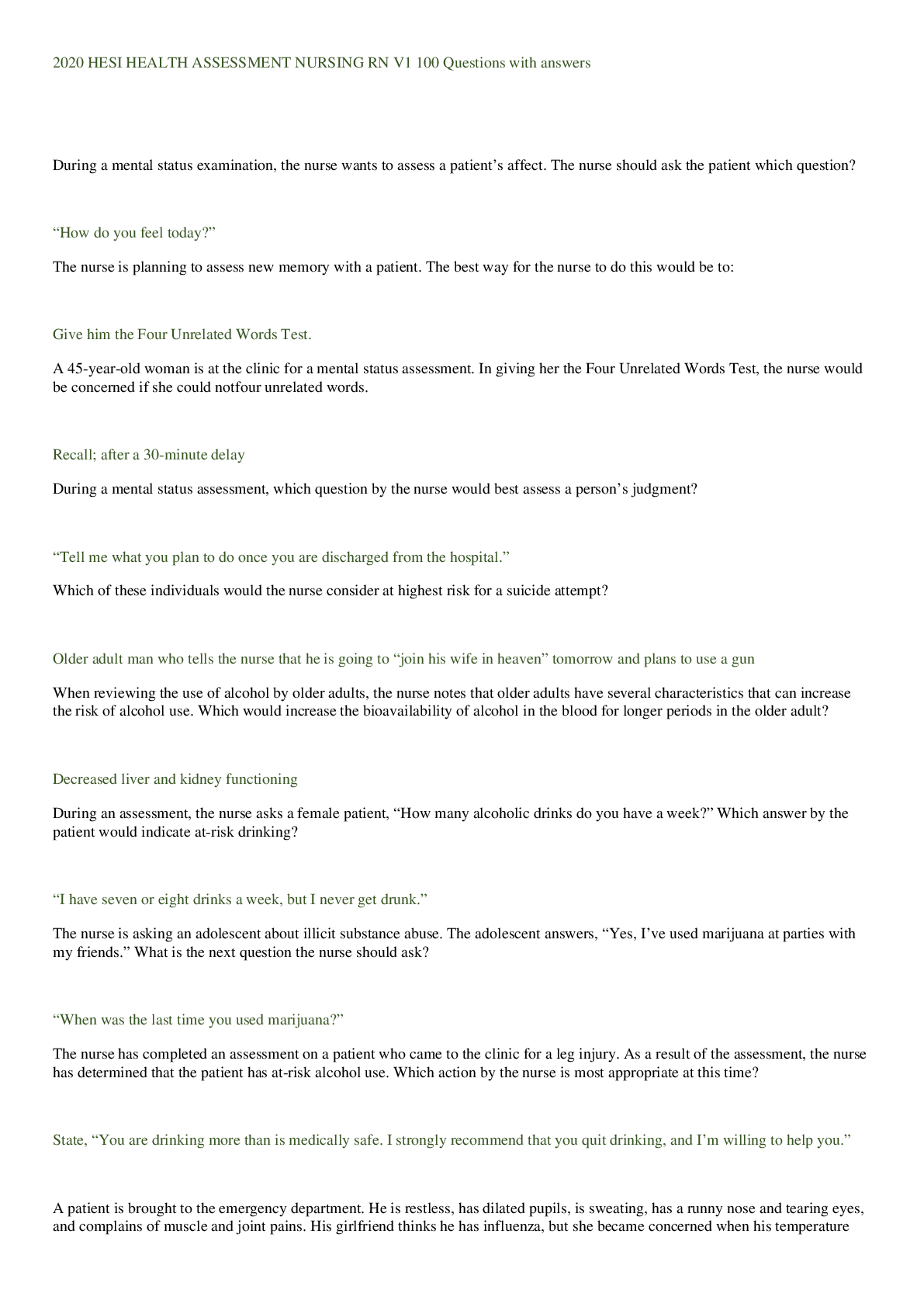
Reviews( 0 )
Document information
Connected school, study & course
About the document
Uploaded On
May 16, 2021
Number of pages
12
Written in
Additional information
This document has been written for:
Uploaded
May 16, 2021
Downloads
0
Views
34


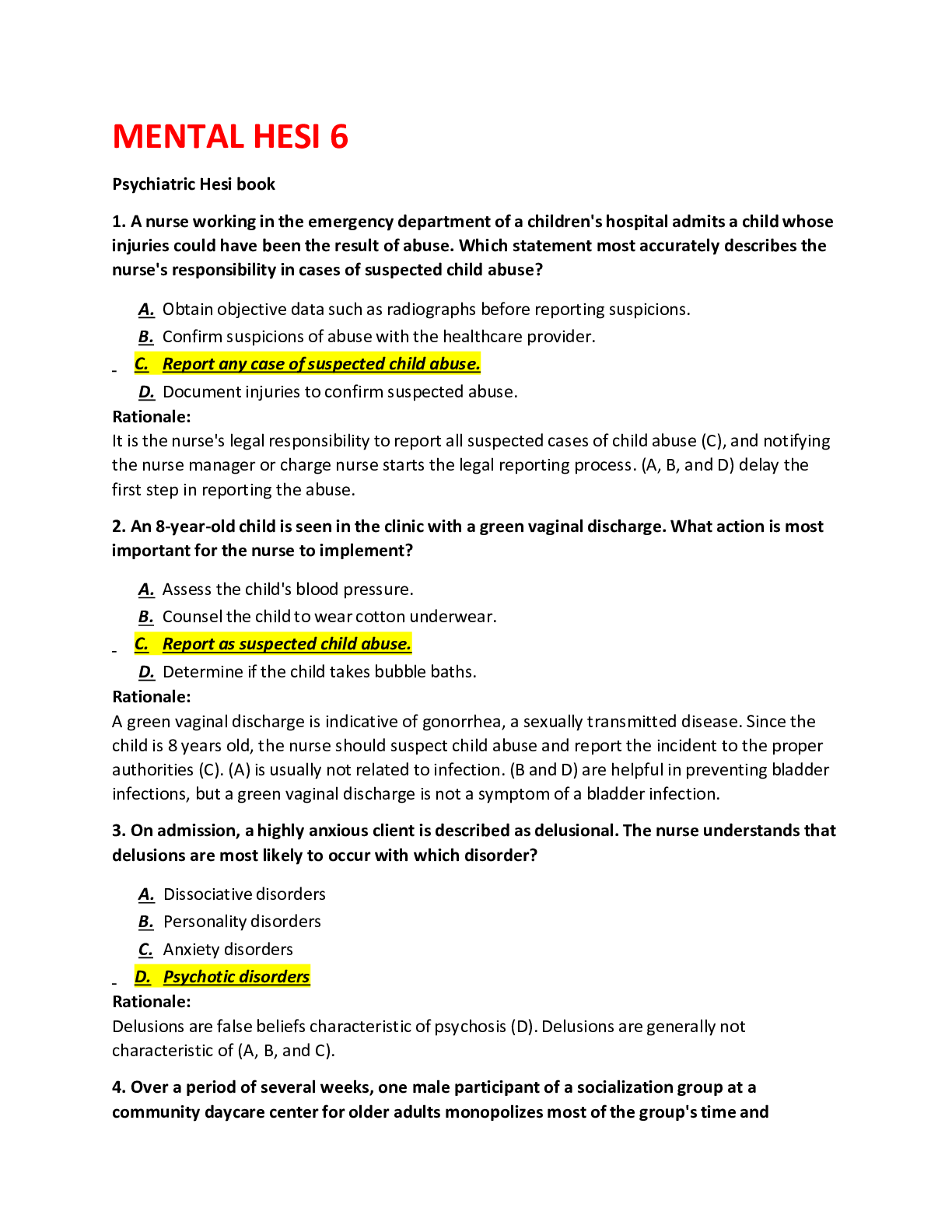
.png)


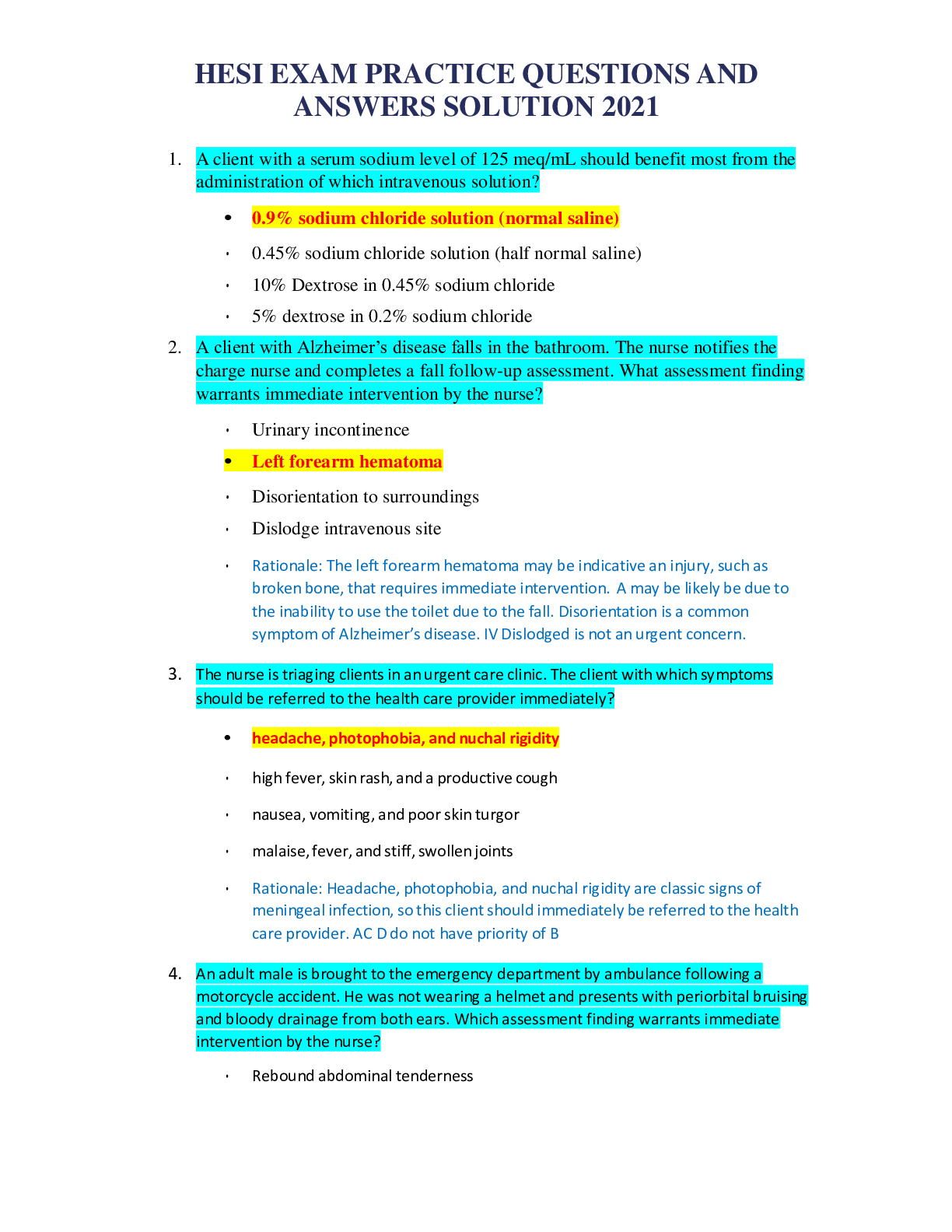
.png)
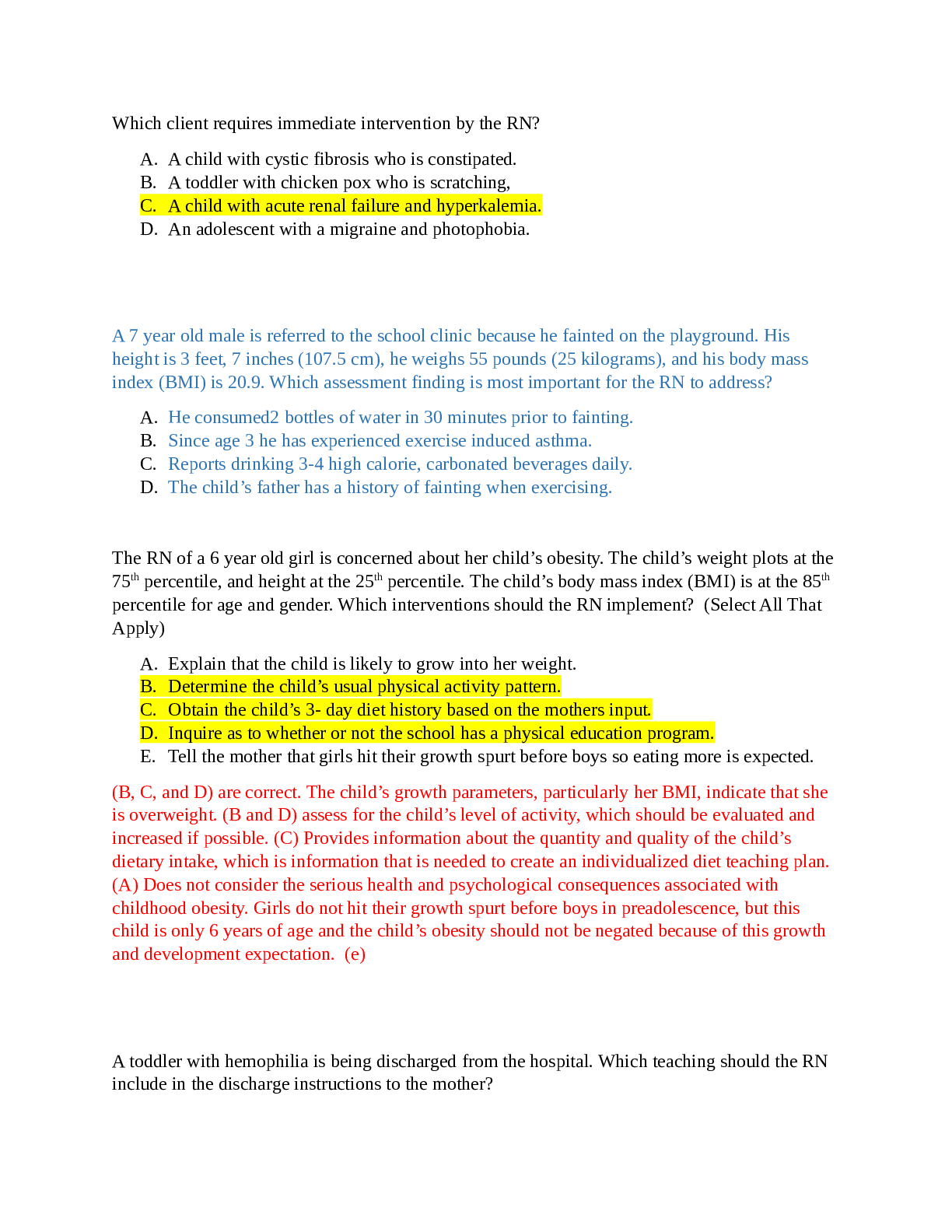



.png)
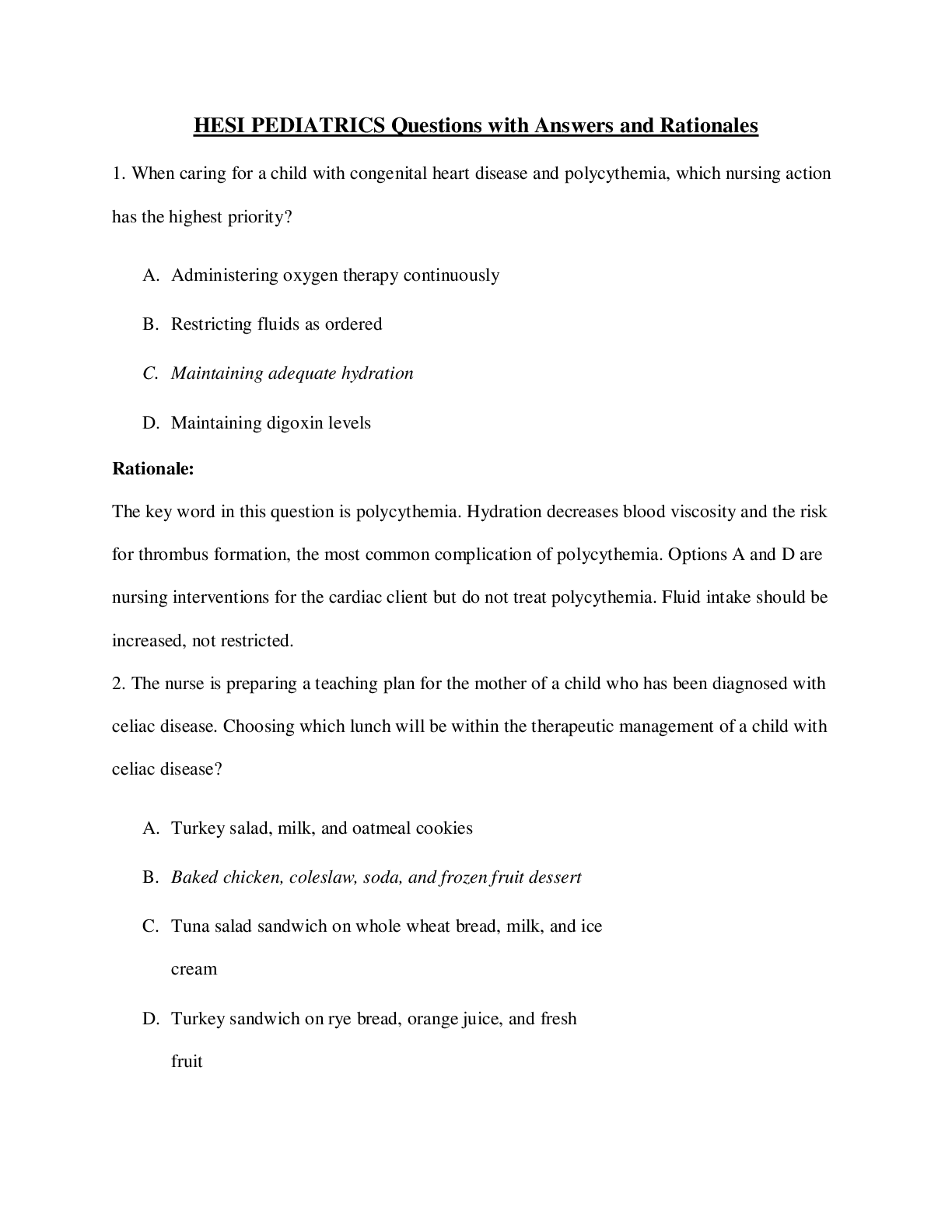
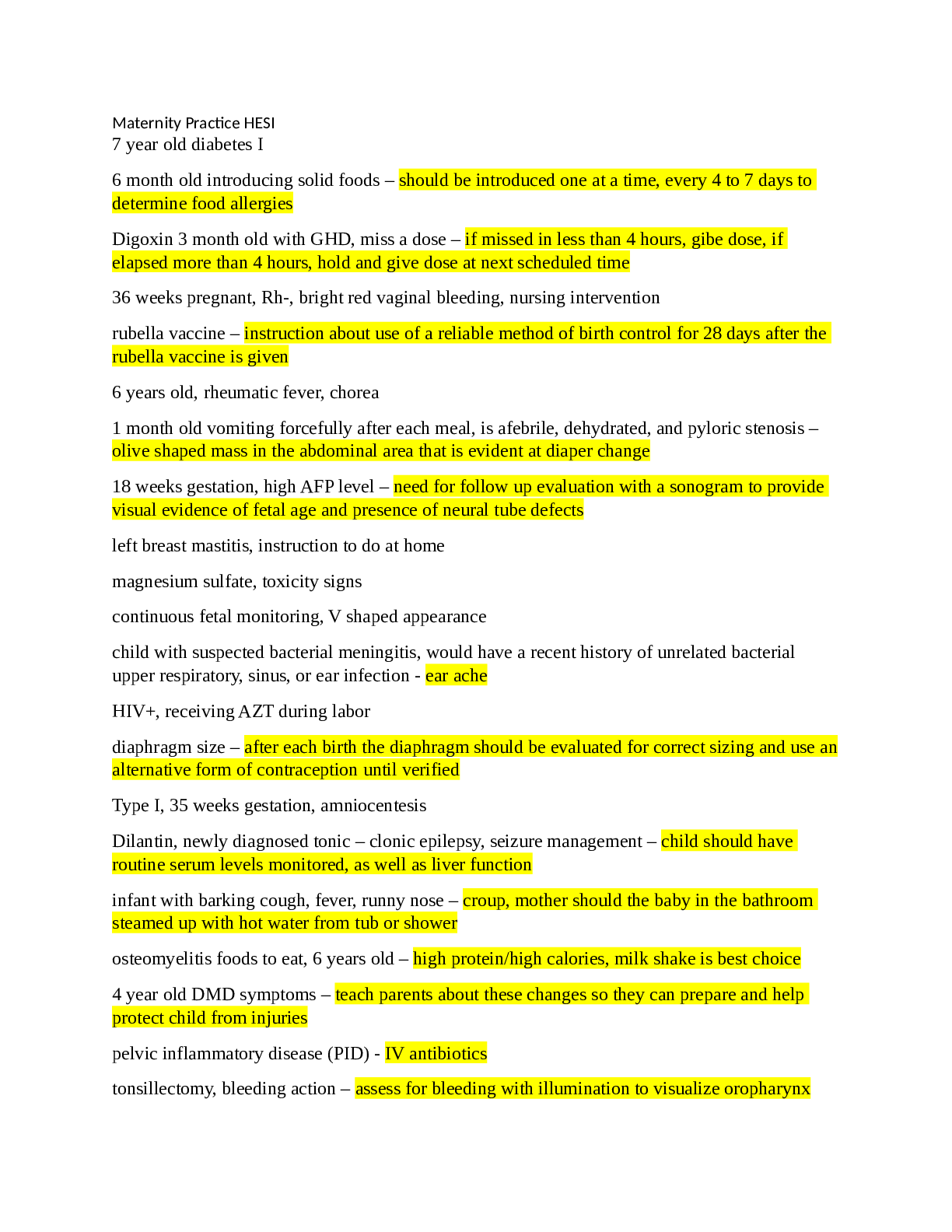



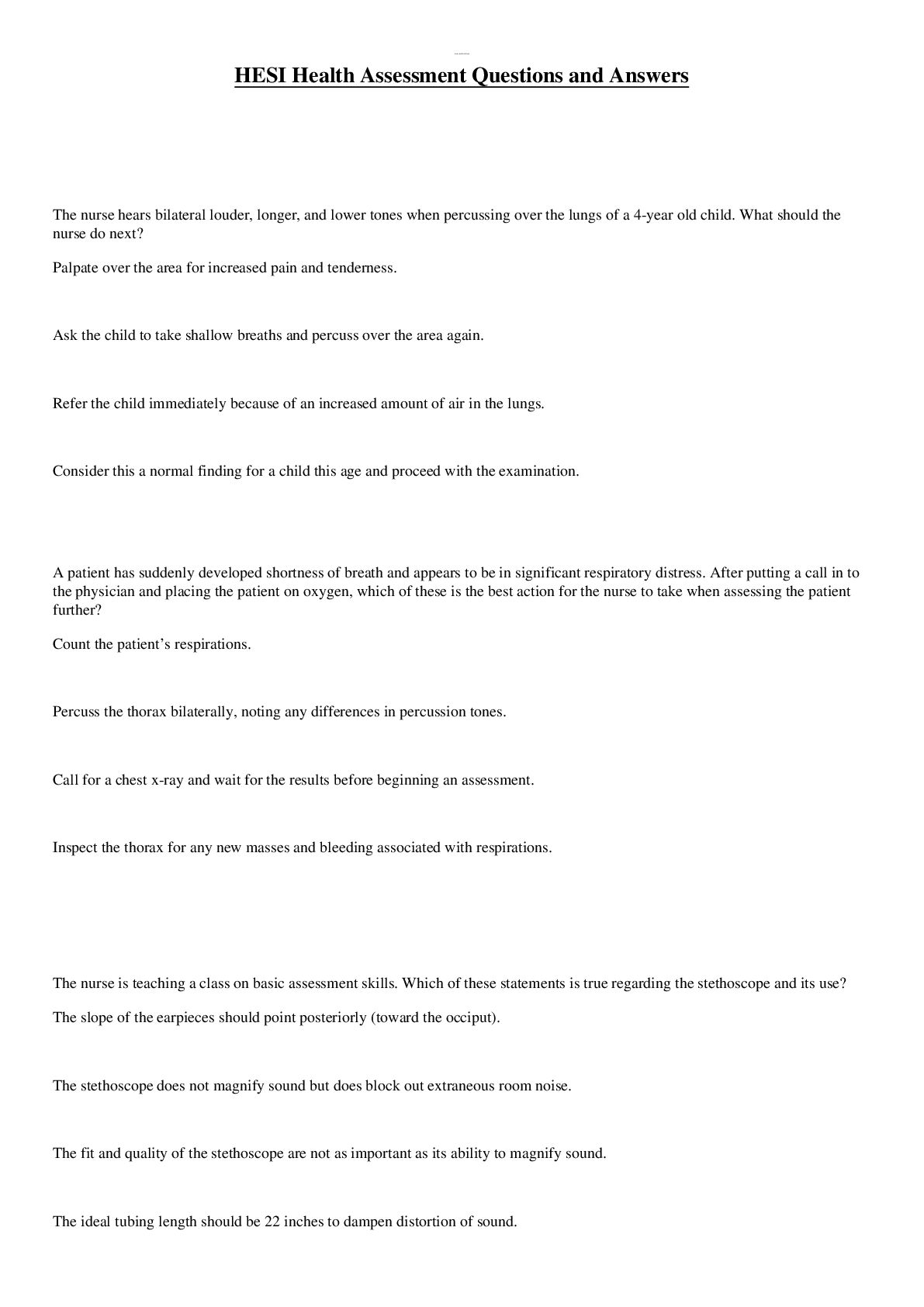
.png)
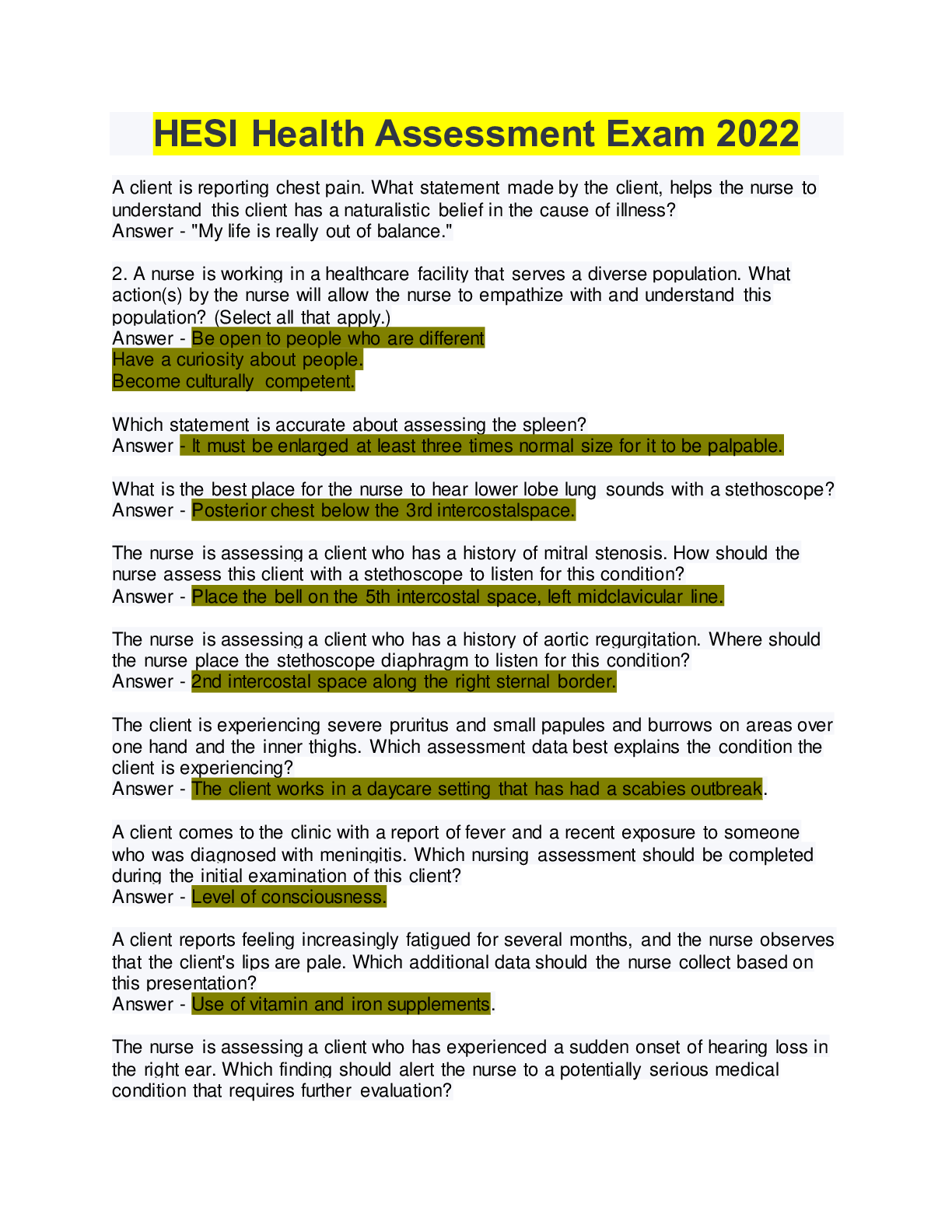
, Latest Questions and Answers with Explanations, All Correct Study Guide, Download to Score A.png)
 - Over 500 Questions (Latest 2021) Correct Study Guide, Download to Score A.png)
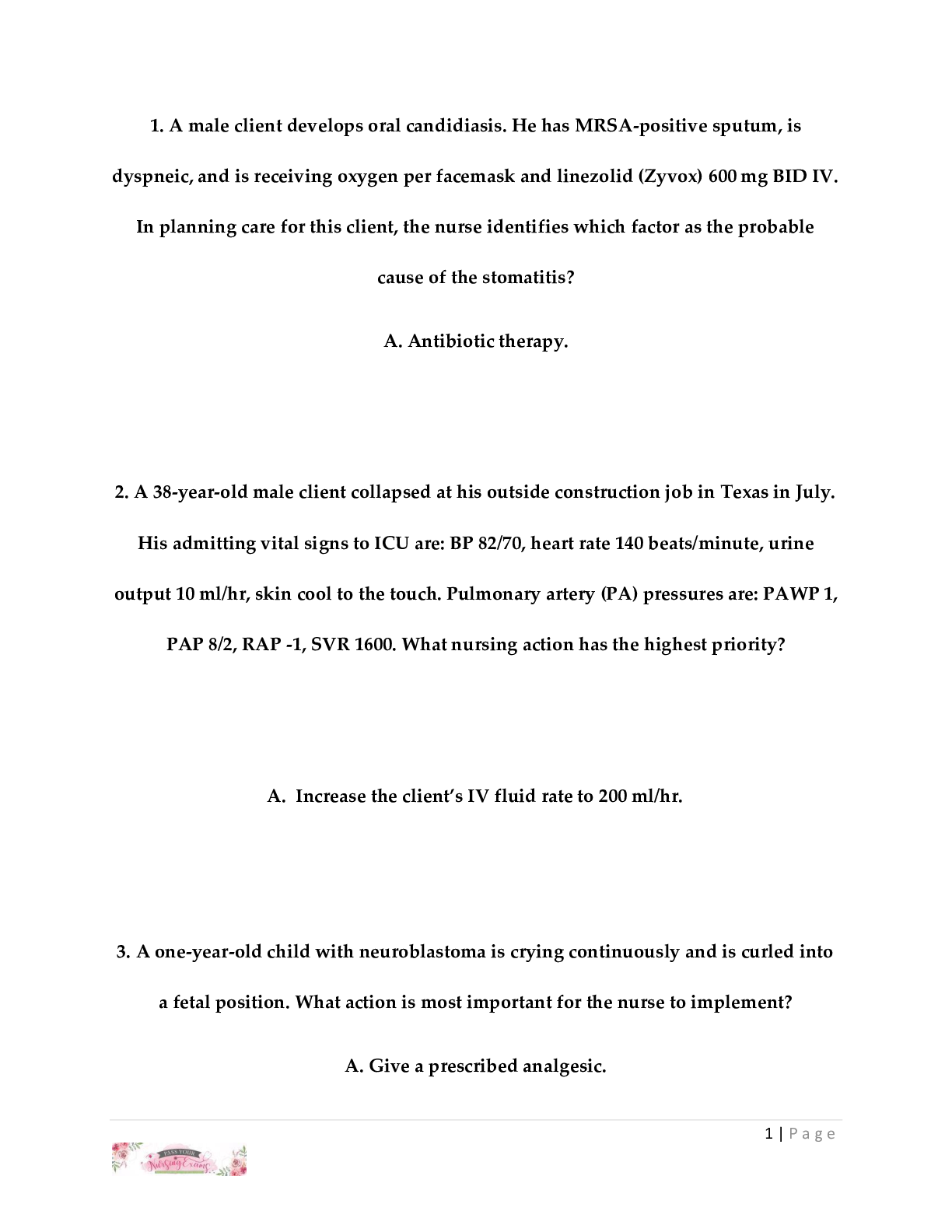

 Correct Study Guide, Download to Score A.png)

